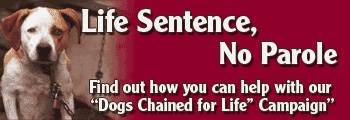Watch MFOA YouTube video and PSA on Dogs Chained for Life (DCFL)
What you should do if you see a DCFL in Maine
“An Act to Protect Dogs Left Outside” - May, 2006 - First in the nation legislation
‘Dogs Chained for Life’ overview and banner
For over 20 years MFOA has been a leader in addressing dogs left outside 24/7, often left with inadequate shelter, tethered in the same area that they sleep, urinate, defecate and eat with overturned or frozen water bowls, no veterinarian care, and little or no canine or human contact, attention or love. In 2006 MFOA passed first in the nation legislation addressing dogs left outside on a continuous basis. We also have a process in getting a ‘Dog Chained for Life’ proper care or released. The 1:20 minute YouTube video (at bottom of page) is a PSA that Maine TV stations have aired from time to time leading MFOA to take action.

What You Should Do if You See a “Dog Chained For Life”
10 Ways to Help
1 Know the law regarding “Outside Dogs.”
Although Maine currently allows tethering 24/7, the State does have very specific requirements regarding dogs left outside for more then 12 hours per day. This Law along with other State Animal Welfare laws can be found at: http:// www.maine.gov/agriculture/aw/.
2 Gather Information
Document the neglect and violations of existing law using pictures and written accountings. Keep record of all communications that you have with authorities concerning the dog’s welfare.
3 Contact the Authorities
Report the dog to your local Animal Control Officer noting specific legal infractions. Be sure to have the physical address of the dog when making a report. Provide as much detail and documentation as possible.
4 Follow-up with the Animal Control Officer to determine what steps he/she has taken to correct the neglect.
5 Continue to monitor the situation.
Occurrences of neglect are rarely resolved with one phone call. If more humane infractions occur, contact the ACO again. If the ACO is not responsive, call his/her superiors (Police, Town Manager,
State Animal Welfare Department).
6 Engage the community.
Most likely, you are not the only person concerned about the dog’s well being. Speak to neighbors about the dog. Ask them to become involved in documentation and communication with authorities and/or the dog owner.
7 Educate the Dog Owner.
Send an educational letter to the dog owner regarding why chaining is inhumane and dangerous.
8 Offer Alternatives to Chaining.
Often dogs are chained outside because they are not house trained, are destructive in the home, are escape artists, or unwanted. Offering the dog owner solutions to these challenges, assistance building a fence, training tips, re-homing assistance, can save a dog’s life.
9 Contact the Media.
Write a letter to the editor of your local paper concerning the plight of the chained dog. Call your local television station.
10 Get Political
Many communities and states have already restricted or outlawed chaining as a means of confinement. Contact your community leaders and state legislators to ask them to pass an anti-tethering law in your community.
L.D. 204, “An Act to Protect Dogs That Are Left Outside” Public Law, Chapter 340. Feb. 2006
This bill establishes tethering and shelter standards specific to dogs that are confined outside on tethers for long periods as its primary means of confinement. Primary means of confinement means the method used to confine a dog for periods of time that exceeds 12 hours in a 24 hour period.- If a dog is tied or confined unattended outdoors under weather conditions that adversely affect the health of the dog, a shelter of suitable size with a floor above ground and water proof roof must be provided to accommodate the dog and protect it from the weather and, in particular, from the severe cold. Inadequate shelter may be indicated by the shivering of the dog due to cold weather for a continuous period of 30 minutes.
- A shelter must be provided that is fully enclosed (four-sided; was three sided) except for a portal.
- The portal must be sufficient size to allow the dog unimpeded passage into and out of the structure. For dogs other than arctic breeds, the portal must be constructed in a manner that keeps wind and precipitation out of the interior.
- The shelter must have clean bedding material sufficient to retain the dog’s normal body heat.
- The chain or tether must be attached to both the dog and the anchor using swivels or similar devices that prevents the chain or tether from becoming entangled or twisted.
- The chain or tether must be attached to a well-fitted collar or harness on the dog.
- The chain or tether must be at least 5 times the length of the dog measured from the tip of the nose to the base of the tail. 2.5 times for arctic breeds (Siberian Huskies, Alaskan Huskies, Malamutes).


